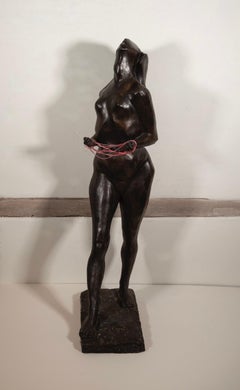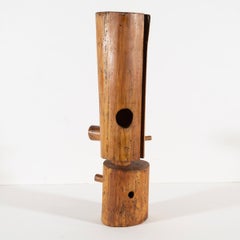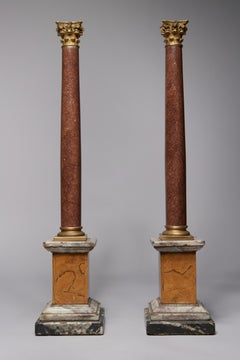Robert Adams More Art
to
1
1
Overall Width
to
Overall Height
to
2
1
1
1
1
4
317
230
168
117
2
2
Artist: Robert Adams
1960s Bronze Sculpture, Female Standing Nude, Figurative
By Robert Adams
Located in Kingsclere, GB
Woman With a Skein, Michael Ayrton, 1963
Additional information:
Medium: Bronze
Height 87 cm (34 1/4 in)
Signed and numbered on base
Provenance
acquired by the present owner in 201...
Category
20th Century Robert Adams More Art
Materials
Bronze
Divided Column Sculpture of Birch by Robert Adams, 1952
By Robert Adams
Located in Kingsclere, GB
Divided Column Sculpture of Birch by Robert Adams, 1952
Additional information:
Medium: Birch
Height, 57 cm (22 1/2 in)
Titled and inscribed with medium...
Category
20th Century Robert Adams More Art
Materials
Birch
Related Items
Close to Heart 1 & 2 - Wood sculpture by Zlata Kornilova
Located in Paris, FR
Sculpture Close to Heart 1 & 2
Limited edition of 12 (each sculpture)
Dimensions:
- Close to heart 1 (black): H. 73. x D. 34 cm
- Close to heart 2 (natural): H. 82. x D. 22 cm
Medi...
Category
21st Century and Contemporary Abstract Robert Adams More Art
Materials
Steel
$6,123
H 28.75 in Dm 13.39 in
Pair of Porphyry Marble Columns with Gilt Bronze Capitals, 19th Century
Located in Beachwood, OH
Pair of Porphyry Marble Columns with Gilt Bronze Capitals, 19th Century
Porphyry marble & gilt bronze
20 x 4.25 x 4.25 inches
Porphyry is an igneous rock, not marble, known for its...
Category
19th Century Robert Adams More Art
Materials
Marble, Bronze
$6,750
H 20 in W 4.25 in D 4.25 in
Il Trovatore, Chirico, Multiples, 1970's, Bronze, Sculpture, Surrealiste
By Giorgio De Chirico
Located in Geneva, CH
Il Trovatore, Chirico, Multiples, 1970's, Bronze, Sculpture, Surrealiste
Il trovatore
Ed. 250 pcs
1971
Bronze with silver patina
H. 31 cm
Signed and date...
Category
1970s Post-War Robert Adams More Art
Materials
Bronze
$16,314
H 12.21 in W 1.97 in
Bellota 7
By María José de la Macorra
Located in Mexico City, CDMX
María José de la Macorra (México, D.F., 1964) realizó sus estudios en la Escuela de Cerámica y Porcelana de Toluca, Mokichi Okada Association,...
Category
2010s Naturalistic Robert Adams More Art
Materials
Bronze
Cobra, Unknown, 20th century, Bronze, Animal, Snake, Design, art deco, Cast
Located in Geneva, CH
Cobra, Unknown, 20th century, Bronze, Animal, Snake, Design, art deco, Cast
Category
20th Century Art Deco Robert Adams More Art
Materials
Bronze
$22,461
H 32 in W 25 in D 18 in
Lapin bijou sonnette, Sandoz, Ring, Rabbit, Bronze, animal, sculpture, 1920's
By Edouard-Marcel Sandoz
Located in Geneva, CH
Lapin bijou, sonnette, circa 1920-1930
Fondry Susse, Ed. 1748 pcs
Bronze with a brown patina
H. 6.5 cm
Signed on the side of the base : Ed.m.Sandoz
Sandoz : Sculpteur Figuriste et An...
Category
1920s Modern Robert Adams More Art
Materials
Bronze
$9,280
H 2.56 in W 3.15 in D 1.19 in
'Space Between' Wooden Sculpture by Camilo Andres Rodriguez Marquez
By Camilo Andres Rodriguez Marquez
Located in Paris, FR
Space Between by Camilo Andres Rodriguez Marquez
Burnt Wood Sculpture
Dimensions: H. 54 x 19.5 x 10 cm
Camilo Andres Rodriguez Marquez is a Col...
Category
21st Century and Contemporary Contemporary Robert Adams More Art
Materials
Wood
$1,040
H 21.26 in W 7.68 in D 3.94 in
Close to Heart 2 - Wood sculpture by Zlata Kornilova
Located in Paris, FR
Sculpture Close to Heart 2
Limited edition of 12
Mediums: old pine, steel, acrylic hand painted, oil
CLOSE TO HEART - Collection
Working on the series I used a “wood with history”...
Category
21st Century and Contemporary Abstract Robert Adams More Art
Materials
Steel
$3,061
H 32.29 in Dm 8.67 in
1920s Italian Signed Bronze Sculpture
By Elisabetta Mayo D’Aloisio
Located in Roma, IT
Bronze on a marble base It bears Mayo's signature.
Trademark Fondart - Lagana Napoli.
“Of the first sculpture, a group of highly vigorous original artistry, all that remains is Ada...
Category
Early 20th Century Art Deco Robert Adams More Art
Materials
Marble, Bronze
$4,728
H 10.24 in W 10.63 in D 11.42 in
Woodpecker Campephilus guat, Contemporary Art, Sustainable Art, Reclaimed Wood
By Davit Nava
Located in Mexico City, MX
Woodpecker Campephilus guat
Contemporary Art, Sustainable Art
Reclaimed Wood
Limited Edition
Signed
About the artist
The beauty of nature
Davit Nava’s wo...
Category
2010s Contemporary Robert Adams More Art
Materials
Wood, Acrylic
$540
H 15.36 in W 13 in D 5.52 in
Lapin assis, tête tournée, Sandoz, 1910's, bronze, animal, rabbits, rare proof
By Edouard-Marcel Sandoz
Located in Geneva, CH
Lapin assis, tête tournée, circa 1919-1921
Fondry Susse, Ed. 3/5 pcs
circa 1919-1921
Rare bronze proof with a brown patina
8.5 x 5.5 x 6.5 cm
Certificate of authenticity issued by th...
Category
1910s Modern Robert Adams More Art
Materials
Bronze
$19,979
H 3.35 in W 2.17 in D 2.56 in
Birdman – Contemporary Hybrid Human-Bird Sculpture by Zura
Located in Brooklyn, NY
More than a creature, Birdman embodies transformation and duality. Is it a guardian, a trickster, or an internal self-reflection? Its bird-like head and humanoid stance invite viewer...
Category
21st Century and Contemporary Contemporary Robert Adams More Art
Materials
Bronze
$4,400 Sale Price
66% Off
H 26 in W 6 in D 5 in
Robert Adams more art for sale on 1stDibs.
Find a wide variety of authentic Robert Adams more art available for sale on 1stDibs. You can also browse by medium to find art by Robert Adams in birch, wood and more. Not every interior allows for large Robert Adams more art, so small editions measuring 1 inch across are available. Customers who are interested in this artist might also find the work of Grayson Perry, Richard Fox, and Pablo Picasso.
Artists Similar to Robert Adams
Damien Hirst


